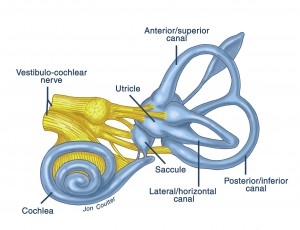Vertigo / Imbalance
Anatomy and Function of the labyrinth
Definition
Do you have vertigo? An imbalance?
Benin Paroxysmal Positional Vertigo (BPPV)
Meniere’s disease
Neuronitis or vestibular neuritis
Labyrinthitis
Dehiscence of the superior canal
Cervical dizziness
Perilymphatic fistula
Migraine and vertigo / Vestibular Migraine
Basilar migraine and vertigo
Vertigo of central origin
Psychogenic vertigo
Vertebrobasilar insufficiency and imbalance
_____________________________________
Anatomy and Function of the labyrinthe
The balance of the body is controlled by three systems:
- The vestibular system in the inner ear. It is composed of five different types of sensors: the three semicircular canals (horizontal, vertical anterior and vertical posterior) and the two otolith organs (utricle and saccule).
- The proprioceptive system at the feet sole and cervical spine
- And the visual system.
All these systems are coordinated by the cerebellum.
The function of the balance system is to stabilize the eyes in the head and the head in space.
It is necessary that the image remains stable on the retina, when the subject is stationary and objects or eyes move. So it is a static and dynamic system.
When there is an alteration or a discrepancy between the messages from these three systems, vertigo or imbalance is developed. Vertigo is often accompanied by nausea and sometimes vomiting.

